University Physics: Exploring Momentum, Impulse, and Car Collisions
VerifiedAdded on 2023/06/03
|8
|2136
|97
Report
AI Summary
This report provides an in-depth analysis of the physics behind car collisions, defining collisions and differentiating between elastic and inelastic types. It explores the role of momentum, impulse, mass, kinetic energy, and velocity in vehicle collisions, highlighting the law of conservation of momentum and energy transformations. The report also examines the influence of Newton's laws of motion on collision dynamics, explaining how each law applies to vehicle and occupant behavior during impact. It further discusses how external forces during collisions affect the extent of injury and damage, emphasizing the relationship between force magnitude and collision severity. The document concludes by summarizing the key physical quantities and principles involved in car collisions, emphasizing the importance of understanding these concepts for vehicle safety and accident analysis. Desklib provides past papers and solved assignments for students.

University
Physics for Car Collision
By
Your Name
Date
Page 1 of 8
© <Your Name> 2018
Physics for Car Collision
By
Your Name
Date
Page 1 of 8
© <Your Name> 2018
Paraphrase This Document
Need a fresh take? Get an instant paraphrase of this document with our AI Paraphraser
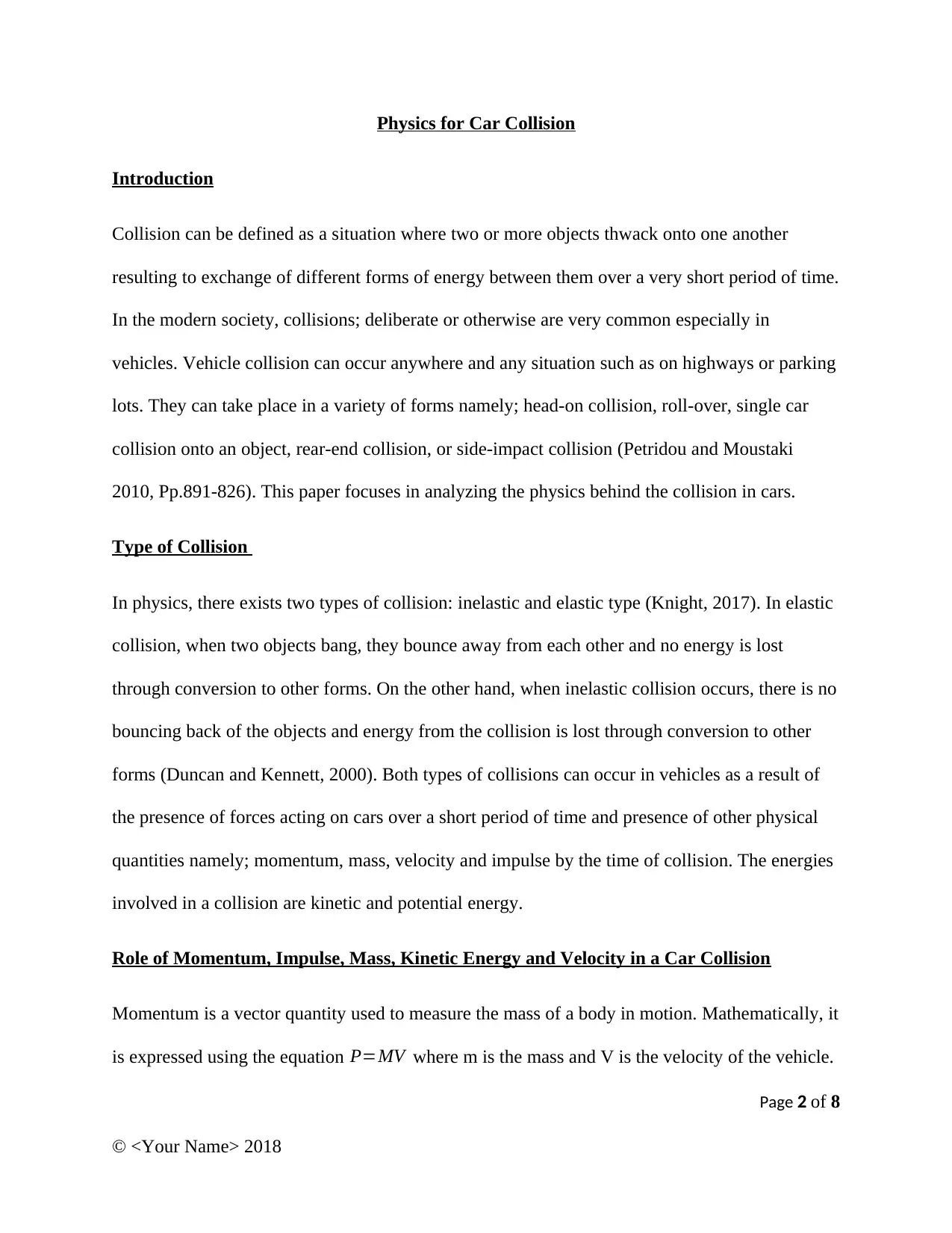
Physics for Car Collision
Introduction
Collision can be defined as a situation where two or more objects thwack onto one another
resulting to exchange of different forms of energy between them over a very short period of time.
In the modern society, collisions; deliberate or otherwise are very common especially in
vehicles. Vehicle collision can occur anywhere and any situation such as on highways or parking
lots. They can take place in a variety of forms namely; head-on collision, roll-over, single car
collision onto an object, rear-end collision, or side-impact collision (Petridou and Moustaki
2010, Pp.891-826). This paper focuses in analyzing the physics behind the collision in cars.
Type of Collision
In physics, there exists two types of collision: inelastic and elastic type (Knight, 2017). In elastic
collision, when two objects bang, they bounce away from each other and no energy is lost
through conversion to other forms. On the other hand, when inelastic collision occurs, there is no
bouncing back of the objects and energy from the collision is lost through conversion to other
forms (Duncan and Kennett, 2000). Both types of collisions can occur in vehicles as a result of
the presence of forces acting on cars over a short period of time and presence of other physical
quantities namely; momentum, mass, velocity and impulse by the time of collision. The energies
involved in a collision are kinetic and potential energy.
Role of Momentum, Impulse, Mass, Kinetic Energy and Velocity in a Car Collision
Momentum is a vector quantity used to measure the mass of a body in motion. Mathematically, it
is expressed using the equation P=MV where m is the mass and V is the velocity of the vehicle.
Page 2 of 8
© <Your Name> 2018
Introduction
Collision can be defined as a situation where two or more objects thwack onto one another
resulting to exchange of different forms of energy between them over a very short period of time.
In the modern society, collisions; deliberate or otherwise are very common especially in
vehicles. Vehicle collision can occur anywhere and any situation such as on highways or parking
lots. They can take place in a variety of forms namely; head-on collision, roll-over, single car
collision onto an object, rear-end collision, or side-impact collision (Petridou and Moustaki
2010, Pp.891-826). This paper focuses in analyzing the physics behind the collision in cars.
Type of Collision
In physics, there exists two types of collision: inelastic and elastic type (Knight, 2017). In elastic
collision, when two objects bang, they bounce away from each other and no energy is lost
through conversion to other forms. On the other hand, when inelastic collision occurs, there is no
bouncing back of the objects and energy from the collision is lost through conversion to other
forms (Duncan and Kennett, 2000). Both types of collisions can occur in vehicles as a result of
the presence of forces acting on cars over a short period of time and presence of other physical
quantities namely; momentum, mass, velocity and impulse by the time of collision. The energies
involved in a collision are kinetic and potential energy.
Role of Momentum, Impulse, Mass, Kinetic Energy and Velocity in a Car Collision
Momentum is a vector quantity used to measure the mass of a body in motion. Mathematically, it
is expressed using the equation P=MV where m is the mass and V is the velocity of the vehicle.
Page 2 of 8
© <Your Name> 2018
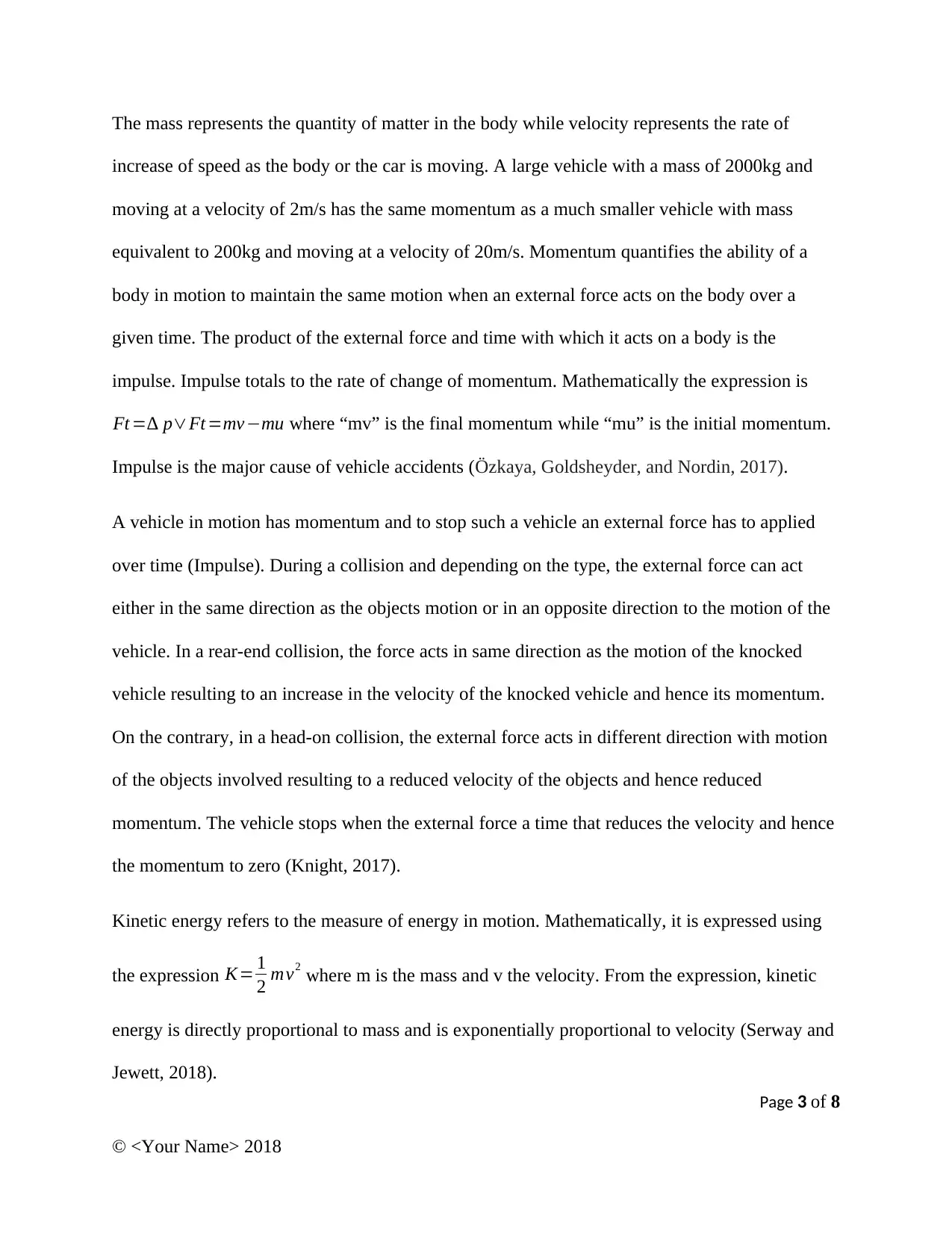
The mass represents the quantity of matter in the body while velocity represents the rate of
increase of speed as the body or the car is moving. A large vehicle with a mass of 2000kg and
moving at a velocity of 2m/s has the same momentum as a much smaller vehicle with mass
equivalent to 200kg and moving at a velocity of 20m/s. Momentum quantifies the ability of a
body in motion to maintain the same motion when an external force acts on the body over a
given time. The product of the external force and time with which it acts on a body is the
impulse. Impulse totals to the rate of change of momentum. Mathematically the expression is
Ft =∆ p∨Ft =mv−mu where “mv” is the final momentum while “mu” is the initial momentum.
Impulse is the major cause of vehicle accidents (Özkaya, Goldsheyder, and Nordin, 2017).
A vehicle in motion has momentum and to stop such a vehicle an external force has to applied
over time (Impulse). During a collision and depending on the type, the external force can act
either in the same direction as the objects motion or in an opposite direction to the motion of the
vehicle. In a rear-end collision, the force acts in same direction as the motion of the knocked
vehicle resulting to an increase in the velocity of the knocked vehicle and hence its momentum.
On the contrary, in a head-on collision, the external force acts in different direction with motion
of the objects involved resulting to a reduced velocity of the objects and hence reduced
momentum. The vehicle stops when the external force a time that reduces the velocity and hence
the momentum to zero (Knight, 2017).
Kinetic energy refers to the measure of energy in motion. Mathematically, it is expressed using
the expression K= 1
2 mv2 where m is the mass and v the velocity. From the expression, kinetic
energy is directly proportional to mass and is exponentially proportional to velocity (Serway and
Jewett, 2018).
Page 3 of 8
© <Your Name> 2018
increase of speed as the body or the car is moving. A large vehicle with a mass of 2000kg and
moving at a velocity of 2m/s has the same momentum as a much smaller vehicle with mass
equivalent to 200kg and moving at a velocity of 20m/s. Momentum quantifies the ability of a
body in motion to maintain the same motion when an external force acts on the body over a
given time. The product of the external force and time with which it acts on a body is the
impulse. Impulse totals to the rate of change of momentum. Mathematically the expression is
Ft =∆ p∨Ft =mv−mu where “mv” is the final momentum while “mu” is the initial momentum.
Impulse is the major cause of vehicle accidents (Özkaya, Goldsheyder, and Nordin, 2017).
A vehicle in motion has momentum and to stop such a vehicle an external force has to applied
over time (Impulse). During a collision and depending on the type, the external force can act
either in the same direction as the objects motion or in an opposite direction to the motion of the
vehicle. In a rear-end collision, the force acts in same direction as the motion of the knocked
vehicle resulting to an increase in the velocity of the knocked vehicle and hence its momentum.
On the contrary, in a head-on collision, the external force acts in different direction with motion
of the objects involved resulting to a reduced velocity of the objects and hence reduced
momentum. The vehicle stops when the external force a time that reduces the velocity and hence
the momentum to zero (Knight, 2017).
Kinetic energy refers to the measure of energy in motion. Mathematically, it is expressed using
the expression K= 1
2 mv2 where m is the mass and v the velocity. From the expression, kinetic
energy is directly proportional to mass and is exponentially proportional to velocity (Serway and
Jewett, 2018).
Page 3 of 8
© <Your Name> 2018
⊘ This is a preview!⊘
Do you want full access?
Subscribe today to unlock all pages.

Trusted by 1+ million students worldwide
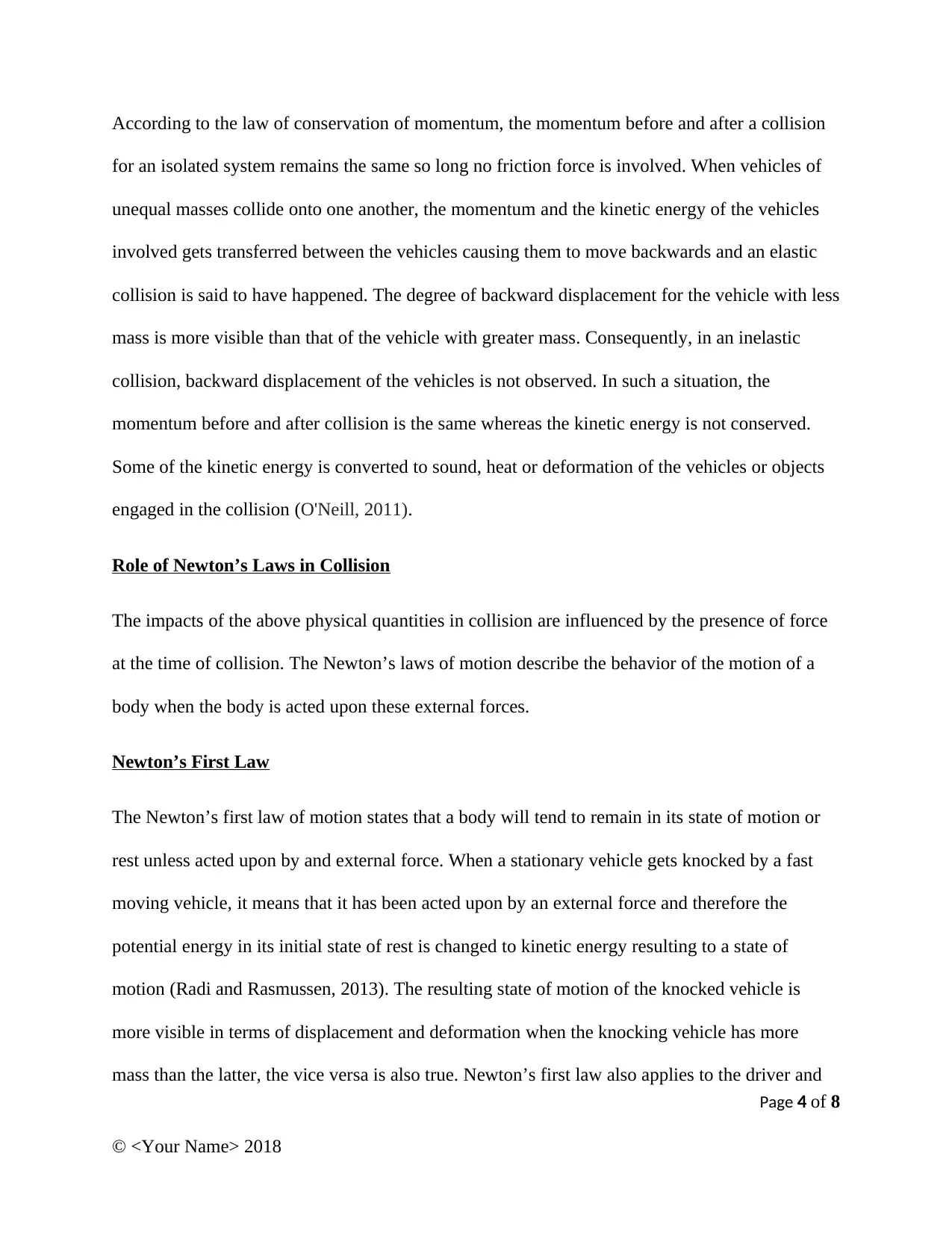
According to the law of conservation of momentum, the momentum before and after a collision
for an isolated system remains the same so long no friction force is involved. When vehicles of
unequal masses collide onto one another, the momentum and the kinetic energy of the vehicles
involved gets transferred between the vehicles causing them to move backwards and an elastic
collision is said to have happened. The degree of backward displacement for the vehicle with less
mass is more visible than that of the vehicle with greater mass. Consequently, in an inelastic
collision, backward displacement of the vehicles is not observed. In such a situation, the
momentum before and after collision is the same whereas the kinetic energy is not conserved.
Some of the kinetic energy is converted to sound, heat or deformation of the vehicles or objects
engaged in the collision (O'Neill, 2011).
Role of Newton’s Laws in Collision
The impacts of the above physical quantities in collision are influenced by the presence of force
at the time of collision. The Newton’s laws of motion describe the behavior of the motion of a
body when the body is acted upon these external forces.
Newton’s First Law
The Newton’s first law of motion states that a body will tend to remain in its state of motion or
rest unless acted upon by and external force. When a stationary vehicle gets knocked by a fast
moving vehicle, it means that it has been acted upon by an external force and therefore the
potential energy in its initial state of rest is changed to kinetic energy resulting to a state of
motion (Radi and Rasmussen, 2013). The resulting state of motion of the knocked vehicle is
more visible in terms of displacement and deformation when the knocking vehicle has more
mass than the latter, the vice versa is also true. Newton’s first law also applies to the driver and
Page 4 of 8
© <Your Name> 2018
for an isolated system remains the same so long no friction force is involved. When vehicles of
unequal masses collide onto one another, the momentum and the kinetic energy of the vehicles
involved gets transferred between the vehicles causing them to move backwards and an elastic
collision is said to have happened. The degree of backward displacement for the vehicle with less
mass is more visible than that of the vehicle with greater mass. Consequently, in an inelastic
collision, backward displacement of the vehicles is not observed. In such a situation, the
momentum before and after collision is the same whereas the kinetic energy is not conserved.
Some of the kinetic energy is converted to sound, heat or deformation of the vehicles or objects
engaged in the collision (O'Neill, 2011).
Role of Newton’s Laws in Collision
The impacts of the above physical quantities in collision are influenced by the presence of force
at the time of collision. The Newton’s laws of motion describe the behavior of the motion of a
body when the body is acted upon these external forces.
Newton’s First Law
The Newton’s first law of motion states that a body will tend to remain in its state of motion or
rest unless acted upon by and external force. When a stationary vehicle gets knocked by a fast
moving vehicle, it means that it has been acted upon by an external force and therefore the
potential energy in its initial state of rest is changed to kinetic energy resulting to a state of
motion (Radi and Rasmussen, 2013). The resulting state of motion of the knocked vehicle is
more visible in terms of displacement and deformation when the knocking vehicle has more
mass than the latter, the vice versa is also true. Newton’s first law also applies to the driver and
Page 4 of 8
© <Your Name> 2018
Paraphrase This Document
Need a fresh take? Get an instant paraphrase of this document with our AI Paraphraser
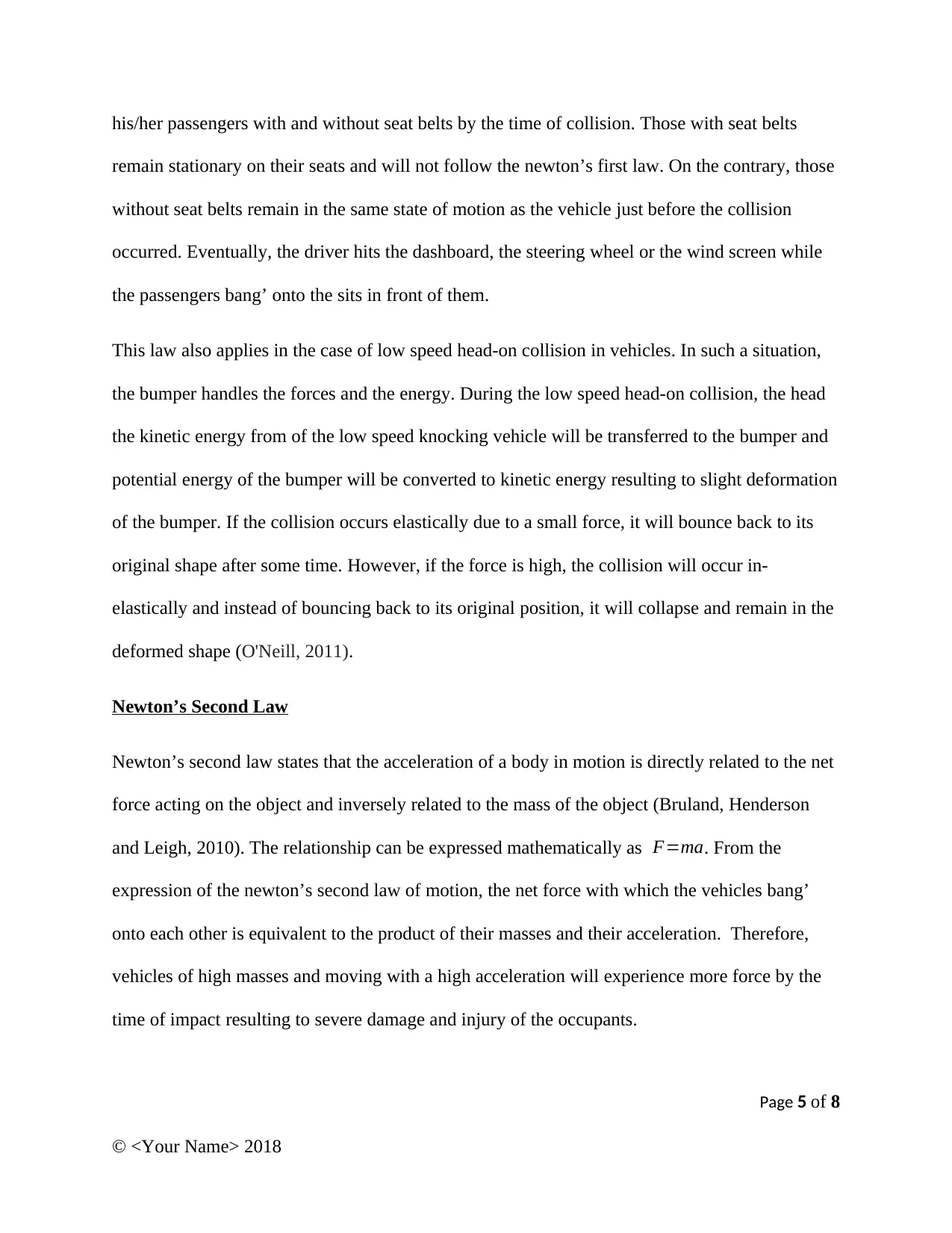
his/her passengers with and without seat belts by the time of collision. Those with seat belts
remain stationary on their seats and will not follow the newton’s first law. On the contrary, those
without seat belts remain in the same state of motion as the vehicle just before the collision
occurred. Eventually, the driver hits the dashboard, the steering wheel or the wind screen while
the passengers bang’ onto the sits in front of them.
This law also applies in the case of low speed head-on collision in vehicles. In such a situation,
the bumper handles the forces and the energy. During the low speed head-on collision, the head
the kinetic energy from of the low speed knocking vehicle will be transferred to the bumper and
potential energy of the bumper will be converted to kinetic energy resulting to slight deformation
of the bumper. If the collision occurs elastically due to a small force, it will bounce back to its
original shape after some time. However, if the force is high, the collision will occur in-
elastically and instead of bouncing back to its original position, it will collapse and remain in the
deformed shape (O'Neill, 2011).
Newton’s Second Law
Newton’s second law states that the acceleration of a body in motion is directly related to the net
force acting on the object and inversely related to the mass of the object (Bruland, Henderson
and Leigh, 2010). The relationship can be expressed mathematically as F=ma. From the
expression of the newton’s second law of motion, the net force with which the vehicles bang’
onto each other is equivalent to the product of their masses and their acceleration. Therefore,
vehicles of high masses and moving with a high acceleration will experience more force by the
time of impact resulting to severe damage and injury of the occupants.
Page 5 of 8
© <Your Name> 2018
remain stationary on their seats and will not follow the newton’s first law. On the contrary, those
without seat belts remain in the same state of motion as the vehicle just before the collision
occurred. Eventually, the driver hits the dashboard, the steering wheel or the wind screen while
the passengers bang’ onto the sits in front of them.
This law also applies in the case of low speed head-on collision in vehicles. In such a situation,
the bumper handles the forces and the energy. During the low speed head-on collision, the head
the kinetic energy from of the low speed knocking vehicle will be transferred to the bumper and
potential energy of the bumper will be converted to kinetic energy resulting to slight deformation
of the bumper. If the collision occurs elastically due to a small force, it will bounce back to its
original shape after some time. However, if the force is high, the collision will occur in-
elastically and instead of bouncing back to its original position, it will collapse and remain in the
deformed shape (O'Neill, 2011).
Newton’s Second Law
Newton’s second law states that the acceleration of a body in motion is directly related to the net
force acting on the object and inversely related to the mass of the object (Bruland, Henderson
and Leigh, 2010). The relationship can be expressed mathematically as F=ma. From the
expression of the newton’s second law of motion, the net force with which the vehicles bang’
onto each other is equivalent to the product of their masses and their acceleration. Therefore,
vehicles of high masses and moving with a high acceleration will experience more force by the
time of impact resulting to severe damage and injury of the occupants.
Page 5 of 8
© <Your Name> 2018
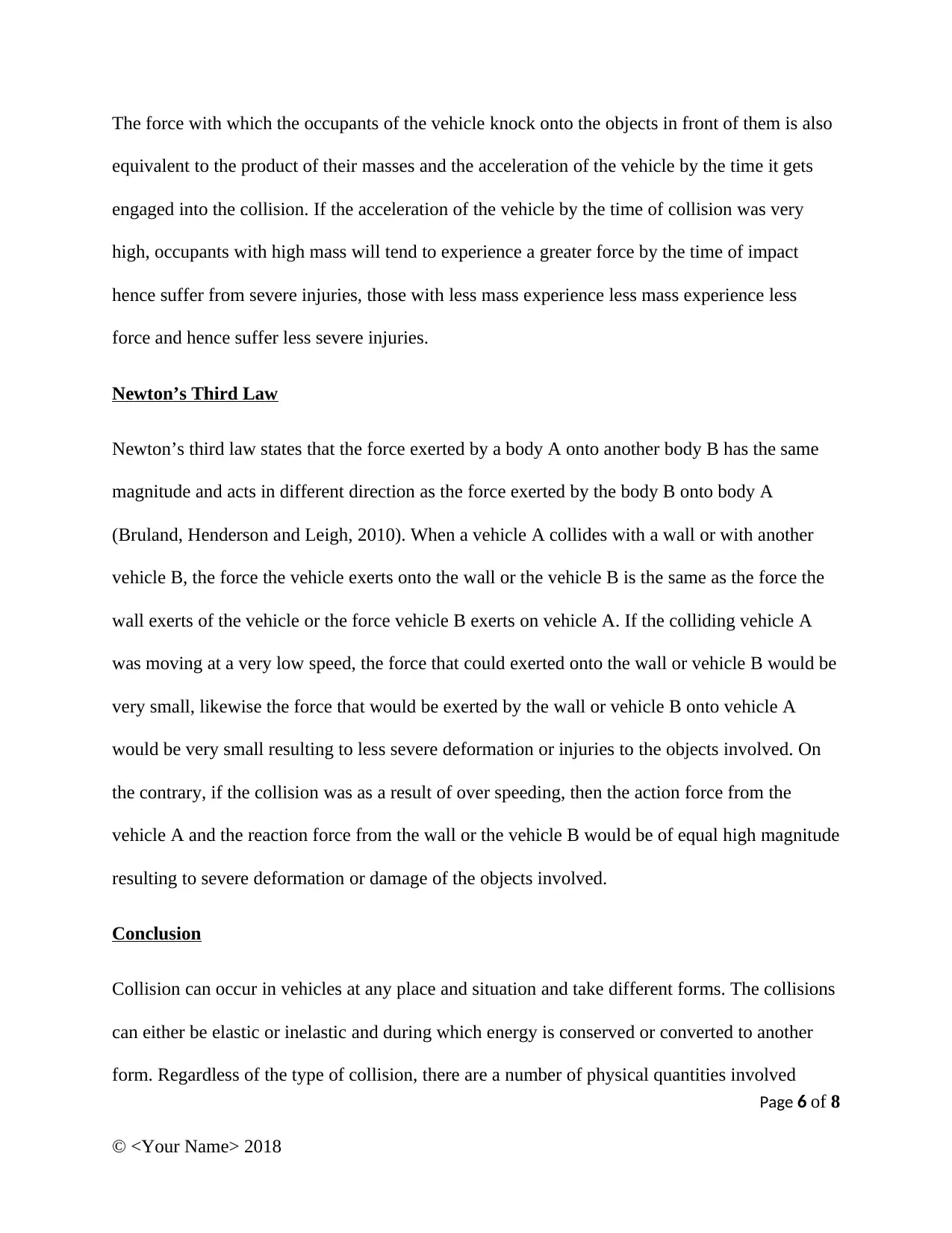
The force with which the occupants of the vehicle knock onto the objects in front of them is also
equivalent to the product of their masses and the acceleration of the vehicle by the time it gets
engaged into the collision. If the acceleration of the vehicle by the time of collision was very
high, occupants with high mass will tend to experience a greater force by the time of impact
hence suffer from severe injuries, those with less mass experience less mass experience less
force and hence suffer less severe injuries.
Newton’s Third Law
Newton’s third law states that the force exerted by a body A onto another body B has the same
magnitude and acts in different direction as the force exerted by the body B onto body A
(Bruland, Henderson and Leigh, 2010). When a vehicle A collides with a wall or with another
vehicle B, the force the vehicle exerts onto the wall or the vehicle B is the same as the force the
wall exerts of the vehicle or the force vehicle B exerts on vehicle A. If the colliding vehicle A
was moving at a very low speed, the force that could exerted onto the wall or vehicle B would be
very small, likewise the force that would be exerted by the wall or vehicle B onto vehicle A
would be very small resulting to less severe deformation or injuries to the objects involved. On
the contrary, if the collision was as a result of over speeding, then the action force from the
vehicle A and the reaction force from the wall or the vehicle B would be of equal high magnitude
resulting to severe deformation or damage of the objects involved.
Conclusion
Collision can occur in vehicles at any place and situation and take different forms. The collisions
can either be elastic or inelastic and during which energy is conserved or converted to another
form. Regardless of the type of collision, there are a number of physical quantities involved
Page 6 of 8
© <Your Name> 2018
equivalent to the product of their masses and the acceleration of the vehicle by the time it gets
engaged into the collision. If the acceleration of the vehicle by the time of collision was very
high, occupants with high mass will tend to experience a greater force by the time of impact
hence suffer from severe injuries, those with less mass experience less mass experience less
force and hence suffer less severe injuries.
Newton’s Third Law
Newton’s third law states that the force exerted by a body A onto another body B has the same
magnitude and acts in different direction as the force exerted by the body B onto body A
(Bruland, Henderson and Leigh, 2010). When a vehicle A collides with a wall or with another
vehicle B, the force the vehicle exerts onto the wall or the vehicle B is the same as the force the
wall exerts of the vehicle or the force vehicle B exerts on vehicle A. If the colliding vehicle A
was moving at a very low speed, the force that could exerted onto the wall or vehicle B would be
very small, likewise the force that would be exerted by the wall or vehicle B onto vehicle A
would be very small resulting to less severe deformation or injuries to the objects involved. On
the contrary, if the collision was as a result of over speeding, then the action force from the
vehicle A and the reaction force from the wall or the vehicle B would be of equal high magnitude
resulting to severe deformation or damage of the objects involved.
Conclusion
Collision can occur in vehicles at any place and situation and take different forms. The collisions
can either be elastic or inelastic and during which energy is conserved or converted to another
form. Regardless of the type of collision, there are a number of physical quantities involved
Page 6 of 8
© <Your Name> 2018
⊘ This is a preview!⊘
Do you want full access?
Subscribe today to unlock all pages.

Trusted by 1+ million students worldwide
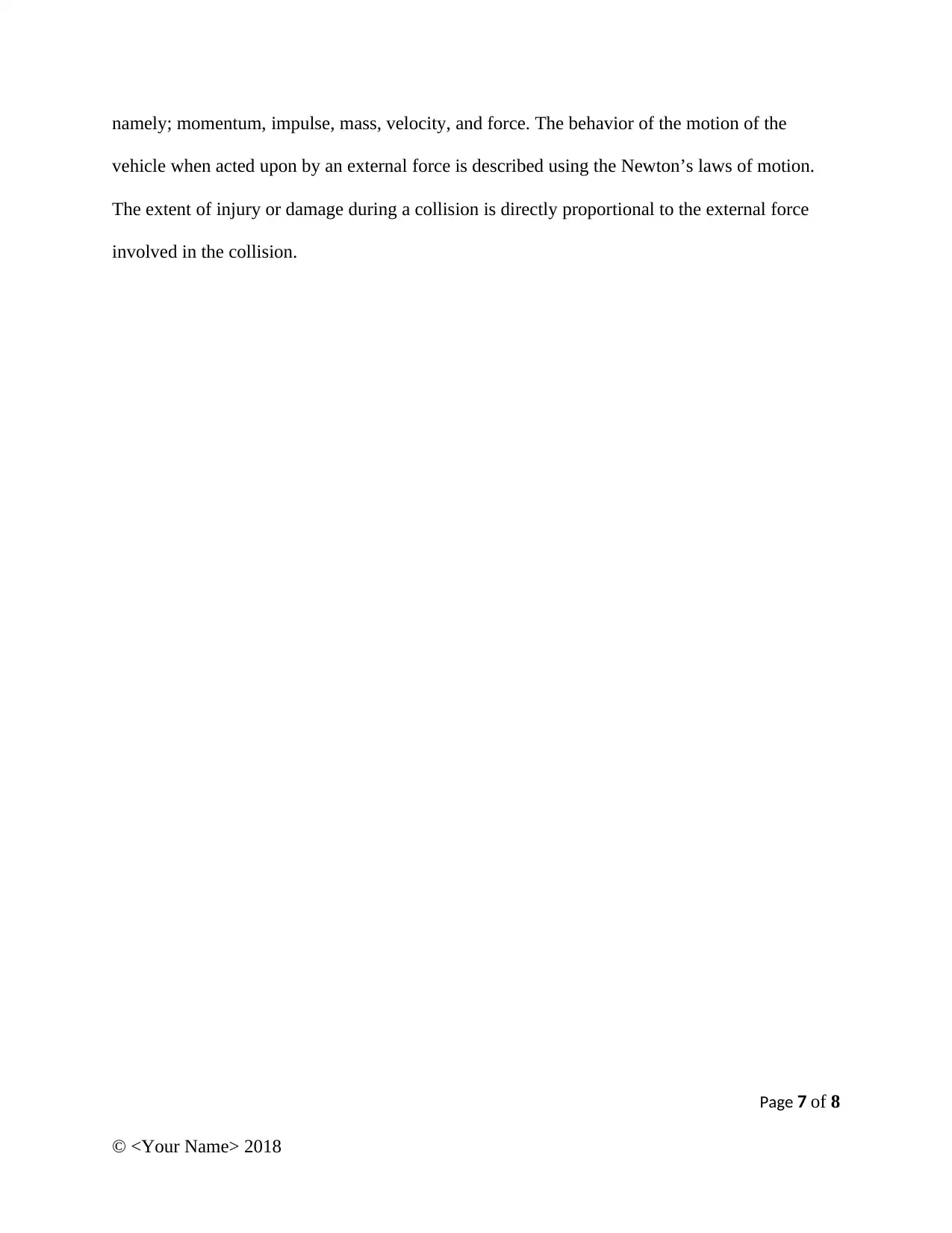
namely; momentum, impulse, mass, velocity, and force. The behavior of the motion of the
vehicle when acted upon by an external force is described using the Newton’s laws of motion.
The extent of injury or damage during a collision is directly proportional to the external force
involved in the collision.
Page 7 of 8
© <Your Name> 2018
vehicle when acted upon by an external force is described using the Newton’s laws of motion.
The extent of injury or damage during a collision is directly proportional to the external force
involved in the collision.
Page 7 of 8
© <Your Name> 2018
Paraphrase This Document
Need a fresh take? Get an instant paraphrase of this document with our AI Paraphraser
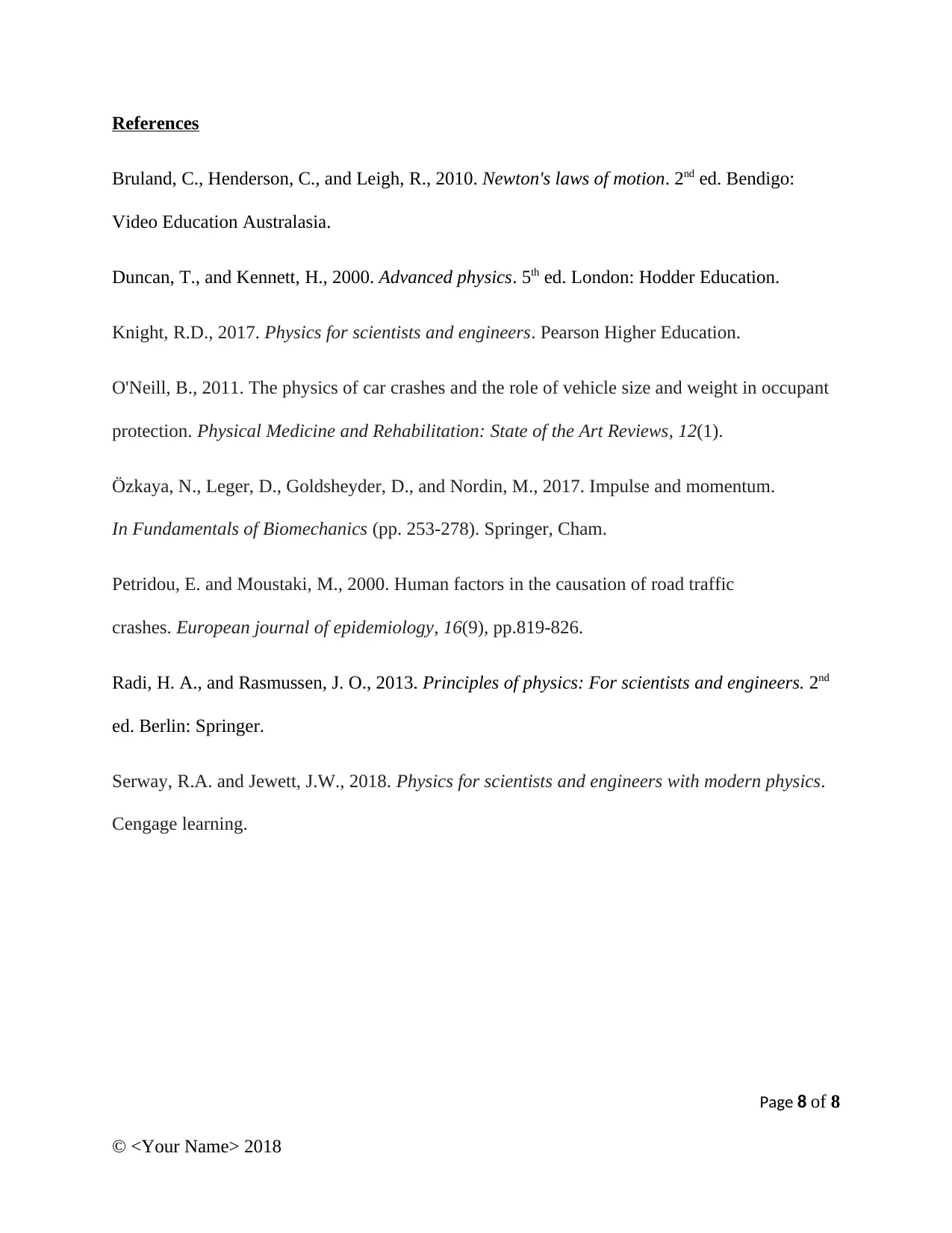
References
Bruland, C., Henderson, C., and Leigh, R., 2010. Newton's laws of motion. 2nd ed. Bendigo:
Video Education Australasia.
Duncan, T., and Kennett, H., 2000. Advanced physics. 5th ed. London: Hodder Education.
Knight, R.D., 2017. Physics for scientists and engineers. Pearson Higher Education.
O'Neill, B., 2011. The physics of car crashes and the role of vehicle size and weight in occupant
protection. Physical Medicine and Rehabilitation: State of the Art Reviews, 12(1).
Özkaya, N., Leger, D., Goldsheyder, D., and Nordin, M., 2017. Impulse and momentum.
In Fundamentals of Biomechanics (pp. 253-278). Springer, Cham.
Petridou, E. and Moustaki, M., 2000. Human factors in the causation of road traffic
crashes. European journal of epidemiology, 16(9), pp.819-826.
Radi, H. A., and Rasmussen, J. O., 2013. Principles of physics: For scientists and engineers. 2nd
ed. Berlin: Springer.
Serway, R.A. and Jewett, J.W., 2018. Physics for scientists and engineers with modern physics.
Cengage learning.
Page 8 of 8
© <Your Name> 2018
Bruland, C., Henderson, C., and Leigh, R., 2010. Newton's laws of motion. 2nd ed. Bendigo:
Video Education Australasia.
Duncan, T., and Kennett, H., 2000. Advanced physics. 5th ed. London: Hodder Education.
Knight, R.D., 2017. Physics for scientists and engineers. Pearson Higher Education.
O'Neill, B., 2011. The physics of car crashes and the role of vehicle size and weight in occupant
protection. Physical Medicine and Rehabilitation: State of the Art Reviews, 12(1).
Özkaya, N., Leger, D., Goldsheyder, D., and Nordin, M., 2017. Impulse and momentum.
In Fundamentals of Biomechanics (pp. 253-278). Springer, Cham.
Petridou, E. and Moustaki, M., 2000. Human factors in the causation of road traffic
crashes. European journal of epidemiology, 16(9), pp.819-826.
Radi, H. A., and Rasmussen, J. O., 2013. Principles of physics: For scientists and engineers. 2nd
ed. Berlin: Springer.
Serway, R.A. and Jewett, J.W., 2018. Physics for scientists and engineers with modern physics.
Cengage learning.
Page 8 of 8
© <Your Name> 2018
1 out of 8
Related Documents
Your All-in-One AI-Powered Toolkit for Academic Success.
+13062052269
info@desklib.com
Available 24*7 on WhatsApp / Email
![[object Object]](/_next/static/media/star-bottom.7253800d.svg)
Unlock your academic potential
Copyright © 2020–2025 A2Z Services. All Rights Reserved. Developed and managed by ZUCOL.



